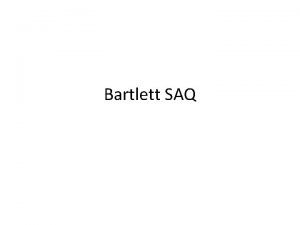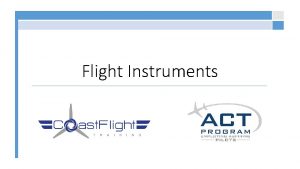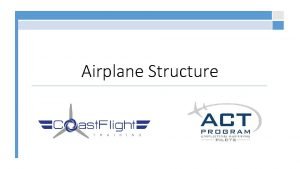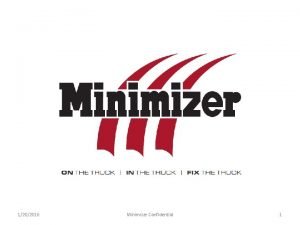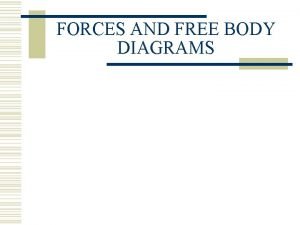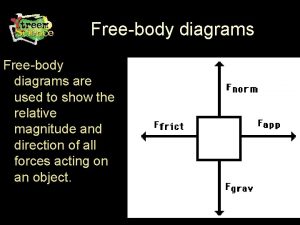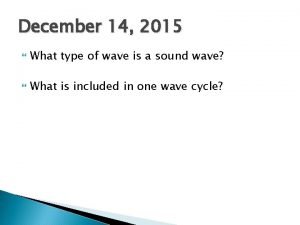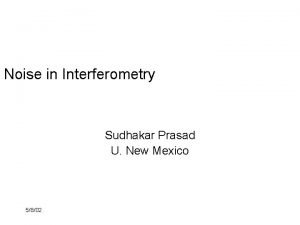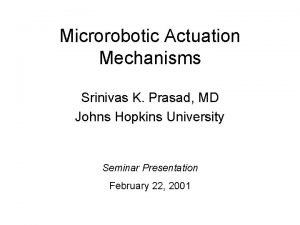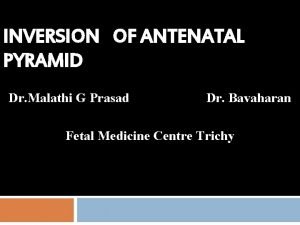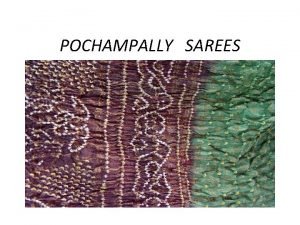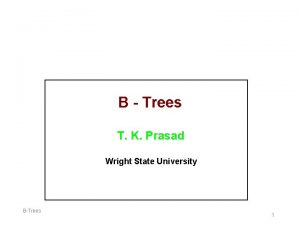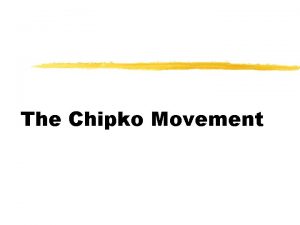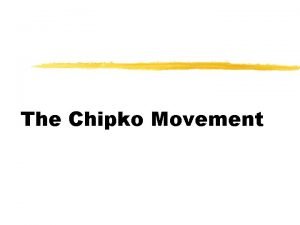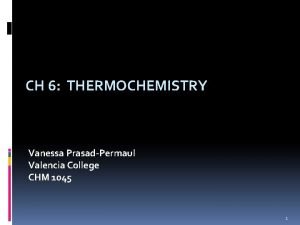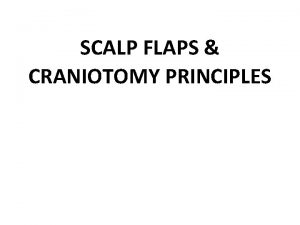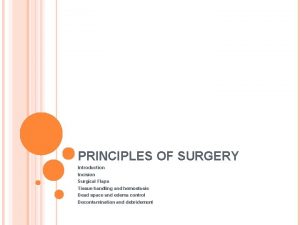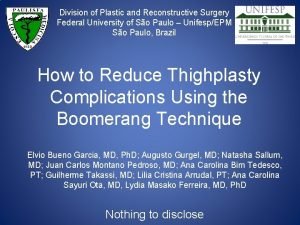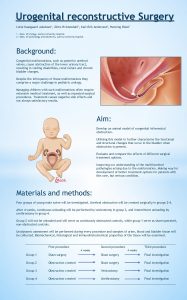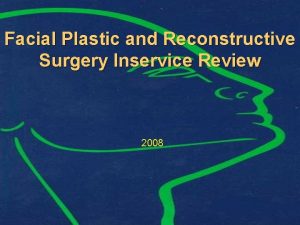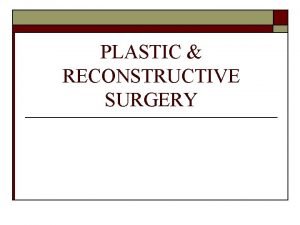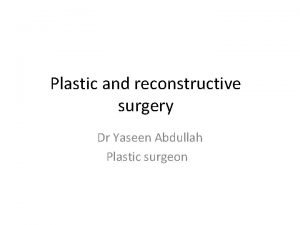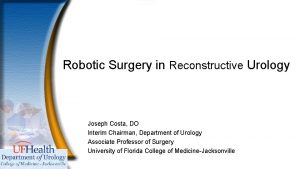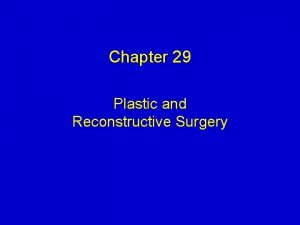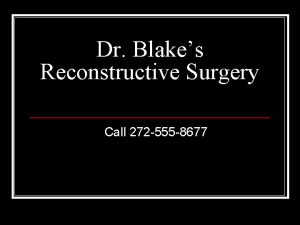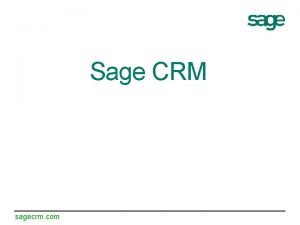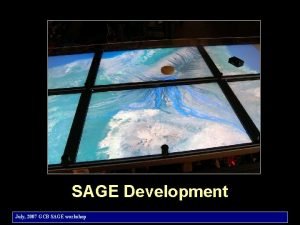FLAPS IN RECONSTRUCTIVE SURGERY NANDINI PRASAD History Sage










































- Slides: 42

FLAPS IN RECONSTRUCTIVE SURGERY NANDINI PRASAD

History : Sage Susruta performing plastic surgery –Cheek flap for absent ear lobe -approx 600 BC

• Modern reconstructive surgery is the combination of various surgical skills and techniques to attempt to restore the normal functional anatomy from the abnormal whether the abnormality be congenital, traumatic, or a result of disease process.

RECONSTRUCTIVE LADDER ØA systematic approach to wound closure. Complex Distant Flaps Local Flaps ØSelection of simple to complex techniques based on local wound requirements and complexity. Skin Grafts Simple ØMay not provide optimal results Direct Closure

RECONSTRUCTIVE TRIANGLE • Integrated approach • Best treatment modality is selected Flaps Microsurgery Tissue Expansion

GOALS • Safety • Form • Function

FLAPS Definition-A flap in plastic surgery is a piece of viable tissue with a blood supply which can be used to reconstruct a tissue defect.

TYPES OF FLAPS Location Blood supply Tissue type

FLAPS BY LOCATION LOCAL FLAP • Raised adjacent to a tissue defect in order to reconstruct it. eg: Rhomboid Flap -face following resection for skin cancer Fasciocutaneous for limb trauma

LOCAL FLAP • Local flap- Raised adjacent to a tissue defect in order to reconstruct it. eg: Rhomboid Flap

METHOD OF MOVEMENT Rotation Transposition Advancement Interpolation

Transposition flap

Interpolation flap

z plasty Ø Type of transposition flap Ø To transfer tissue into a scar or contracturure & to lengthen it Ø To reposition a scar within lines of minimal tension

Location - Distant Flap Defect brought to donor site

Location - Distant Flap Ø donor site and defect both moved into close proximity – eg. Cross leg flap, Cross arm flap, Cross finger flap, Cross toe flap

Location - Distant Flap Ø Defect remains static. Tube pedicle transfer Ø To provide biood supply during transfer Ø To eliminate raw surface to decrease infection

Location -Free Flaps (Free Tissue Transfer) • Flap raised with blood supply, disconnected and then connected to artery and vein in recipient site by microvascular surgery. Eg. Free TRAM flap

FLAPS –BLOOD SUPPLY • Random pattern flaps • Axial pattern flaps

RANDOM PATTERN FLAPS • Flap of skin and subcutaneous tissue perfused by dermal-subdermal plexus of vessels.

Axial pattern flaps • Based on blood supply to the skin and subcutaneous tissue by a specific cut. perforator. eg: lat. forehead-sup. temporal

BASED ON TISSUE TYPE Skin flaps Muscle flaps Composite flaps

SKIN FLAPS • Raised at the subdermal level taking full thickness of skin attached at one side thru which blood supply enters the flap.

DELAY- technique to enhance flap circulation ensure flap survival Standard delay Strategic delay

Muscle flaps • Provide good bulk for filling large defects Function may also be restored LD FLAP

COMPOSITE FLAPS • Fasciocutaneous • Myocutaneous • Ostiomyocutaneous

TRAM flap

FLAP MODIFICATIONS Ø Tissue expansion enlarging cutaneous territory over 6 wks-3 month interval Ø Skin stretching Ø Segmental transposition flap Ø Vascularised bone flaps Ø Sensory flap

USE • Congenital cleft lip-local flap syndactyly-LF with/without SG giant naevus-tissue exp+LF

Developmental -bell’s palsy Trauma scar revision nasal loss open tibial # pressure sores

• Neoplasia skin cancer oral cancer breast cancer

RECONSTRUCTIVE PRINCIPLES • PRE OPERATIVELY 1. Defect Analysis Impact on pt survival & quality of life Location , Size Physical components, vascular status Bacteriology of exposed structures 2. Timing

3. Flap Design Ø actual defect size Ø delayed until wound debridement/ tumour extirpation 4. Vascular Pedicle 5. Systemic Factors obesity tobacco use hypertension

INTRAOPERATIVELY 1. Patient Positioning 2. Flap Elevation 3. Pedicle Identification & Evaluation 4. Tension 5. Adjacent Structures 6. Hemostasis 7. Transfusion Requirements

POST OPERATIVE MANAGEMENT 1. Positioning 2. Dressings 3. Suction Drains 4. Antibiotics 5. Mobilisation 6. Rehabilitation

FLAP FAILURE. Preoperative causes • • Poor flap design Inadequate flap size Violation of the blood supply to the flap Design of the flap in radiated or traumatized tissue • Patient-related factors such as smoking, hypertension, and poor overall health

Intraoperative causes • Technical errors such as injuring the blood supply during dissection • Creating too much tension on the flap • Twisting or kinking the flap pedicle can cause flap ischemia and necrosis.

Postoperative causes Ø Hematoma can cause pressure on the flap and lead to necrosis. Ø Infection also can cause partial or complete flap necrosis

FLAP NECROSIS Ø Occurs due to congestion Clinical Presentation skin acutely congested cyanosed blanching mometarily Blistering implies necrosis is imminent

Prevention proper flap design enhancement of vascularity proper care during & after transfer Treatment detach excise reinset

BCC EXCISED 5 days 3 wks 48 hrs 9 months

THANK YOU
 Abdel marques md
Abdel marques md Nandini name signature
Nandini name signature Discuss schema theory ib psychology
Discuss schema theory ib psychology Constructive vs reconstructive memory
Constructive vs reconstructive memory Criminal psychology definition
Criminal psychology definition Schema theory saq
Schema theory saq Atomatoflames flaps
Atomatoflames flaps Arctic wolf adaptation
Arctic wolf adaptation Open truss structure
Open truss structure Airplane landing distance graph
Airplane landing distance graph Atomatoflames
Atomatoflames Flaps of featherless skin between their front and back legs
Flaps of featherless skin between their front and back legs Minimizer fast flap
Minimizer fast flap Free body diagram egg falling
Free body diagram egg falling A flying squirrel is gliding (no wing flaps)
A flying squirrel is gliding (no wing flaps) Frieda the fly flaps its wings
Frieda the fly flaps its wings Butter flaps
Butter flaps Annie prasad
Annie prasad Sudhakar prasad
Sudhakar prasad Srinivas prasad md
Srinivas prasad md Edamana prasad iitm
Edamana prasad iitm Prasad gourineni md
Prasad gourineni md Malathi prasad
Malathi prasad Combination reaction example
Combination reaction example How to make pochampally saree step by step
How to make pochampally saree step by step Dr vasudeva prasad atluri
Dr vasudeva prasad atluri Prasad raghavendra
Prasad raghavendra Lawrence prasad
Lawrence prasad Admission under reception order
Admission under reception order Tk prasad
Tk prasad The gita project
The gita project What can we learn privately
What can we learn privately Gaura devi
Gaura devi Sunderlal bahuguna quotes malayalam
Sunderlal bahuguna quotes malayalam Astha prasad
Astha prasad Prasad calyam
Prasad calyam Vanessa prasad permaul
Vanessa prasad permaul Vanessa prasad permaul
Vanessa prasad permaul Rachit prasad
Rachit prasad Bill prasad
Bill prasad Amita prasad ias
Amita prasad ias Engage global solutions
Engage global solutions Prasad calyam
Prasad calyam





